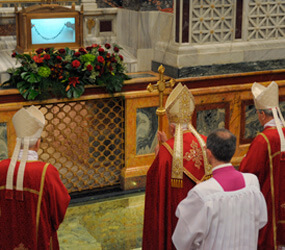ROME – Closing the year of St. Paul, Pope Benedict XVI announced that tests done on the presumed tomb of the Apostle revealed the presence of bone fragments from a human who lived between the first and second century.
“This seems to confirm the unanimous and uncontested tradition that they are the mortal remains of the Apostle Paul,” the pope said during an evening prayer service June 28 at Rome’s Basilica of St. Paul Outside the Walls.
The basilica has long been held to be the burial site of St. Paul, but because of the destruction and rebuilding of the basilica, the exact location of the tomb was unknown for centuries. Vatican officials announced in December 2006 that several feet below the basilica’s main altar and behind a smaller altar, they had found a roughly cut marble sarcophagus beneath an inscription that reads: “Paul Apostle Martyr.”
Because part of the sarcophagus is buried beneath building material, Vatican officials determined they could not dig it out to open and examine the contents. Initially they tried to X-ray it to see what was inside, but the marble was too thick.
Pope Benedict said a “very tiny perforation” was drilled into the marble so that a small probe could be inserted in order to withdraw fragments of what was inside.
In addition to traces of purple linen, a blue fabric with linen threads and grains of red incense, he said they found bone fragments.
The bone fragments “underwent a carbon-14 analysis carried out by experts who did not know their place of origin,” the pope said, adding that the results “indicate they belong to a person who lived between the first and second century.”
Before beginning the evening prayer service, Pope Benedict descended the steps at the foot of the basilica’s main altar and prayed before a small window that allows the public to see a portion of the sarcophagus.
In his introductory remarks, the pope said the 2008-2009 commemoration of the 2,000th anniversary of St. Paul’s birth was an opportunity to help Christians rediscover St. Paul’s writings, “which exhort us to preach the word in every age and to be irreproachable in healthy doctrine. If we want to receive the crown of justice, we must continue to fight the good fight and keep the faith.”
From personal experience, St. Paul knew that conversion was a life-long process and that Christians are called to become new people in Christ, not just in the way they behave, but also in the way they think and the way they look at the world, Pope Benedict said in his 25-minute homily.
“The world always is looking for something new because, rightly, it is not content with concrete reality,” he said.
But Christians learn from St. Paul that the newness they are looking for, the newness that will save them and save the world, is a mature faith in the Gospel.
“In recent years, ‘adult faith’ has become a widespread slogan. Frequently it is used to mean the attitude of those who no longer listen to the church and its pastors, but autonomously choose what to believe and what not to believe,” he said.
Too often, he said, expressing an opinion contrary to the teaching of the church is described as being courageous.
“In reality, however, one does not need courage for this because one always can count on public applause. Instead, courage is needed to adhere to the teaching of the church even when this contradicts the ideas of the modern world,” the pope said.
“It is part of adult faith, for example, to defend the inviolability of human life from the first instant, radically opposing the principle of violence, including in the defense of the most defenseless human creatures,” he said.
“Recognizing the marriage of one man and one women for their entire lives as the order established by the Creator and reestablished by Christ is part of adult faith,” the pope said.
“Adult faith does not allow itself to be pushed here and there by every breeze,” he said.
Pope Benedict said the life and writings of St. Paul also emphasize the fact that Christ died for all men and women of all cultures and all times.
“The crucified Christ embraced the entire universe in every dimension. He takes the world into his hands and carries it up to God,” he said.
“We pray that the Lord will help us recognize something of the vastness of his love. We pray that his love and truth will touch our hearts,” the pope said.


